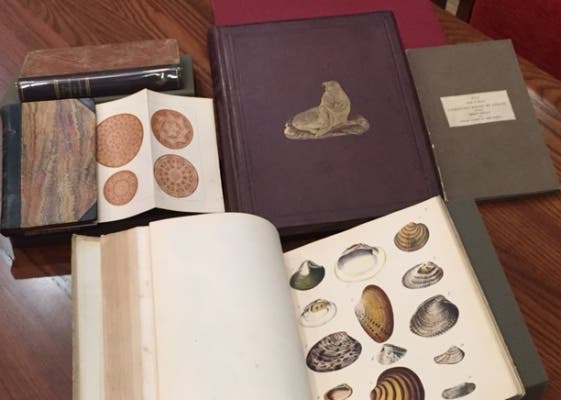LHL Acquisitions Include Books on Bees, Nineteenth-Century Mail Delivery
Over the past three months, the Linda Hall Library has added six new volumes to its rare book collection, ranging from bees to lathing for women.
All of the books were published in the eighteenth and nineteenth centuries, and cover life sciences, engineering, and other aspects of science and technology. Ben Gross, the Associate Vice President of Collections, provides this brief summary of the newly acquired volumes:
Friedrich Berge, Conchylienbuch (1855)
This beautiful German natural history book contains over 700 colorful illustrations of mussels, snails, and other mollusks. It also provides aspiring naturalists with information about the best ways to prepare and store their shell collections.
Mary Gascoigne, Handbook of Turning (1842)
Published anonymously in 1842, this book subverted nineteenth-century assumptions about gender and technology by teaching women to produce decorative objects using a lathe. The author, later identified as Mary Gascoigne, observed that there was nothing intrinsically masculine about the use of machine tools. “What occupation,” she asked, “can be more interesting or elegant than ornamenting wood or ivory in delicate and intricate patterns, and imitating, with the aid of the lathe, the beautiful Chinese carving, so much and so justly admired?”
François Huber, Nouvelles observations sur les abeilles: adressées à M. Charles Bonnet (1792)
Swiss naturalist François Huber devoted much of his life to exploring the life cycle and behavior of honeybees. He also designed a new type of beehive, which featured moveable wooden frames that could be turned like the pages of a book. Huber published his observations in this 1792 volume, though as he points out in its introduction, he did not actually observe any of the phenomena under discussion himself. He had begun going blind at the age of 15 and worked closely with an assistant to carry out his research.
James MacQueen, A General Plan for a Mail Communication by Steam (1838)
After managing a sugar plantation in Grenada, geographer James MacQueen became convinced that advances in shipping technology could do more to improve communications between Britain and its colonies. In this report, MacQueen outlined the political and economic benefits of a specialized fleet of steamships that could transport letters and packages across the globe. His proposal eventually led to the establishment of the Royal Mail Steam Packet Company, which remained in operation until 1982. MacQueen’s discussion is particularly noteworthy for its suggestion to construct a canal across the Isthmus of Panama, an idea which would only come to fruition 76 years later!
Pierre-Louis Moreau de Maupertuis, Essai sur la formation des corps organisés (1754)
Although perhaps better known as an advocate for Newtonian physics, Pierre-Louis Moreau de Maupertuis also engaged in Enlightenment discussions of reproduction and heredity. In this essay, he described how visible traits can be passed from parents to their offspring. Based on his experience breeding dogs and genealogical investigations of a Berlin family whose members had six fingers, Maupertuis argued that variations in inherited characteristics might eventually lead to the creation of new species, foreshadowing later debates about evolution by natural selection.
Charles M. Scammon, The marine mammals of the north-western coast of North America (1874)
Charles Scammon spent over a decade hunting whales off the coast of California before realizing that he really preferred studying their behavior. After a brief stint in the U.S. Revenue Marine (a precursor to the Coast Guard), he wrote this encyclopedic volume about the whales, dolphins, seals, and other marine mammals that he encountered during his travels. The first edition of this book is particularly scarce since many copies were destroyed in the 1906 San Francisco earthquake.






